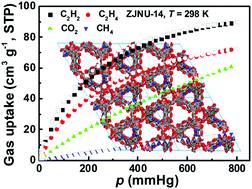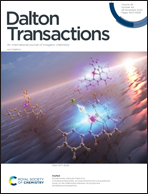An N-oxide-functionalized nanocage-based copper-tricarboxylate framework for the selective capture of C2H2†
Abstract
The selective capture of C2H2 from C2H2–C2H4 and C2H2–CO2–CH4 mixtures is a very essential but highly challenging process during C2H4 and C2H2 purification in the chemical industry. In this work, by virtue of using oxygen-atom-rich C2H2 recognition sites, we, for the first time, designed and synthesized an N-oxide-functionalized tricarboxylate ligand and utilized it to successfully construct a copper-based MOF. N-Oxide functionalization exerted a significant effect on the ligand conformation, thus resulting in a new topological network that is different from that of the unoxidized parent compound. With a moderate surface area and the immobilization of N-oxide functionality and carboxylate oxygen atoms in two nanocages, the title MOF exhibited promising potential for the multifunctional separation of C2H2/C2H4 and C2H2/CO2/CH4 mixtures under ambient conditions, as shown by pure-composition isotherm measurements, IAST predictions, and molecular modeling studies.



 Please wait while we load your content...
Please wait while we load your content...